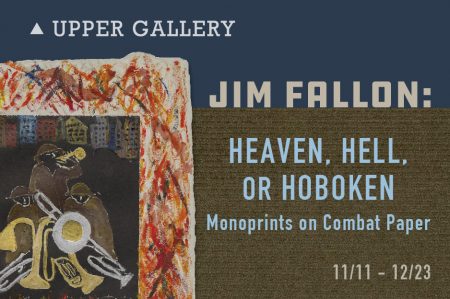Jim Fallon – “Heaven, Hell or Hoboken”
November 11 - December 23, 2018

The Hoboken Historical Museum is pleased to commemorate the centennial of Armistice Day, the end of World War I, with the opening reception for a WWI-inspired art exhibit by veteran Jim Fallon: “Heaven, Hell or Hoboken: Monoprints on Combat Paper.” The reception is Sunday, Nov. 11, 6 – 8 pm, and the show is on view in the Upper Gallery through December 23.
The exhibit comprises 15 works of art, most inspired by the 100th anniversary of America’s participation in World War I, 1917 – 1918. The name of Fallon’s show is inspired by General Pershing’s famous rallying cry to the troops, “Heaven, Hell or Hoboken,” near the close of the war, as Hoboken served as the main port of embarkation and return.
Many pieces in Fallon’s Armistice Day series were produced for the Frontline Arts Center in Branchburg, NJ, and also shown in an exhibition in Jersey City Hall last year to commemorate the anniversary of America’s involvement in the Great War. Several pieces incorporate images he researches online, such as zeppelins, the Lusitania, and battle scenes from a century ago, as well as from his own service in Vietnam.
One piece, “Harlem Hellfighters WWI,” a linocut with acrylic on combat paper, combines Fallon’s deep love of jazz music with an homage to the famous 369th regiment that served in World War I as a segregated unit of mostly black and Puerto Rican soldiers from Harlem. These soldiers not only distinguished themselves in battle, but also during and after the war, when musicians from the unit introduced American jazz to Europe. Many returned to Paris after the war to escape the police harassment that made it difficult for them to perform in New York, spawning an enduring fan base for jazz in Europe.
The themes of jazz music, nature and military service recur throughout Fallon’s art. Retired from a career in the hospitality industry as owner of the New York jazz club, the Half Note, and eventually as head bartender for the Century Plaza Hotel in Beverly Hills, the Hoboken native and his wife returned to the Mile Square City several years ago to look after their aging parents.
Fallon came to the practice of art late in life, about five years ago, after joining in an art class offered by the Disabled American Veterans group. He was serving as a veterans service officer, helping other disabled vets gain access to programs like art therapy at the Veterans Center in Secaucus.
“At first, I thought I couldn’t draw more than stick figures,” he says, but with the help of his fellow veterans, he quickly developed skills with multiple media, from drawing to painting to paper making. He learned the craft of making paper from shredded veterans’ uniforms at the Frontline Arts Printmaking Center of New Jersey, in Branchburg. Called “combat paper,” the end result is a textured paper that serves as the backdrop for his art. He’s part of a veterans’ group that invites other veterans to join in the process of converting their old uniforms into paper, which also fosters therapeutic conversations among the veterans from different wars who gather weekly to share the craft.
In 1968 at age 28, Fallon had served as a medic in Vietnam in a field hospital unit comprising Army Reservists from New York. The group didn’t think their unit would be called up and fought the deployment in court, all the way to the Supreme Court. The government prevailed, and the unit was assigned, perhaps as a punishment, to staff a POW hospital. He soon realized that many of the enemy’s army were just like them, kids, some conscripted at gunpoint. Not all were hardened Vietcong combatants.
His Army Medical Unit also provided assistance to a remote village orphanage, delivering provisions of food, toys and medical supplies. The children were always excited to see the truck with the big red cross. The experience stayed with him, resurfacing years later in a work he titled, “Orphan Opus ’68,” which is included in the Upper Gallery show. The piece received the 1st place award in the October 2015 National Veterans Creative Arts Festival in Durham, N.C.
Exposure to Agent Orange also marked him, as it did over 400,000 other Vietnam veterans, although it took 20 years in his case to show up as bone cancer. He lost the humerus bone in his right arm, replaced by a titanium bone. Through therapy, he regained use of the lower part of his arm, but can’t lift heavy objects. It doesn’t prevent him from making art, which he spends several hours a day on now, in his Hoboken home.
Fallon has deep roots in Hoboken, though he was raised in Jersey City, after his family moved to the Heights neighborhood shortly after he was born in Hoboken. His great grandfather, after serving the Union Army in the Civil War, came to Hoboken and settled, working at a leather factory. His father was a Hoboken fireman during the Great Depression, but after an injury on the job, he found work as so many others did on the Hoboken piers. He was a dock checker in a longshoremen crew and recalled when the film “On the Waterfront” was being shot on the pier next to his, taking a lot of men off the job.
The exhibit is supported by a block grant from the State/County Partnership program for the Arts, administered by the Hudson County Division of Cultural and Heritage Affairs.
